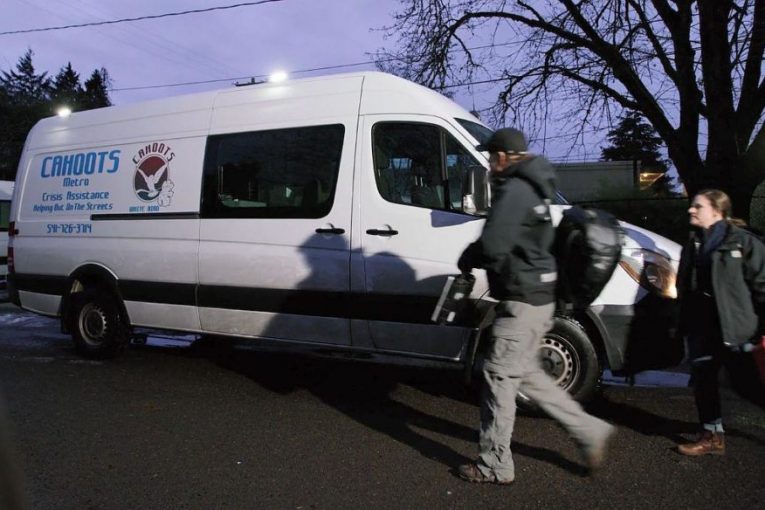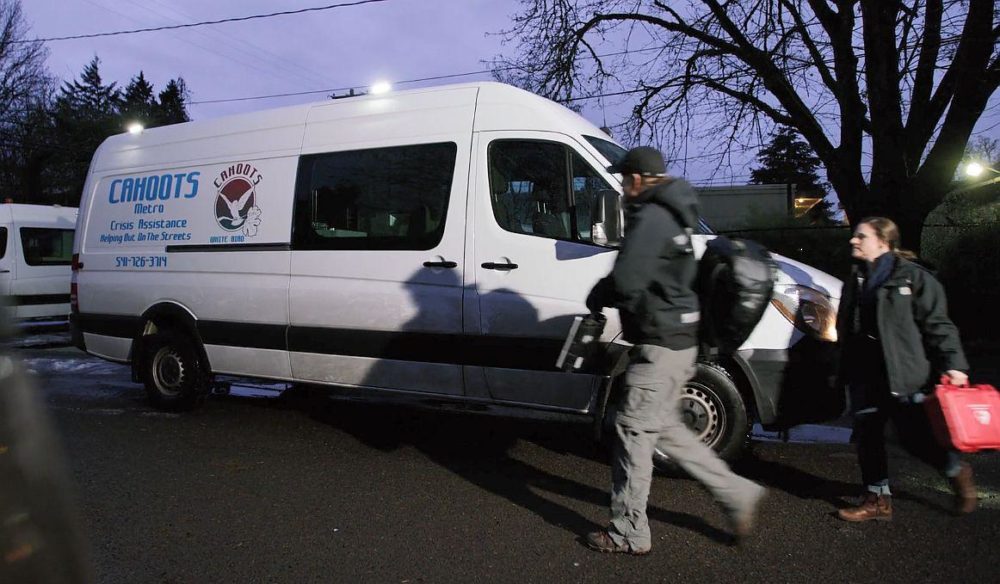

By David M. Greenwald
The Davis City Council in December signed on to a nine-point plan for reimagining policing. Some of the steps will be more difficult than others, but one clear path for change lies with a model that has been successfully deployed for 30 years in Eugene, Oregon.
Nationally, as the push is on for reform, reformers have now focused on the crisis-response program that many believe has resulted in a reduced footprint of law enforcement and a decrease in the likelihood of police violence.
At the core is the belief that, while the phrase “defund the police” is wrought with polarization and misinterpretation, there is also a fundamental belief that we are calling on police to do too many things, problems that cannot and should not be solved through the use of an armed police response.
We have also seen—repeatedly—that mental health calls are fraught with danger, as police respond to situations where command and respond scenarios do not work, and police are often ill-equipped to counsel and de-escalate in such situations.
The case of Daniel Prude in Rochester, NY, is one example. Prude, acting erratically, was having a mental-health crisis, and the police responded by placing a mesh hood over his head and holding him to the  ground until he stopped moving. He would die a week later from “complications of asphyxia in the setting of physical restraint,” according to the medical examiner.
ground until he stopped moving. He would die a week later from “complications of asphyxia in the setting of physical restraint,” according to the medical examiner.
Proper response by the police? Would a better trained responder have been able to resolve the situation without the loss of life?
Defenders of the police will often make the point—if people would simply comply with police orders, there would be a reduction of shootings. But that simplistic approach overlooks fundamental complexities of the combination of mental health crises and self-medication that often lead to the most dangerous scenarios for both police and victims.
The notion that someone may lack the capacity to comply is often lost. The notion that a simple command model of policing that ignores the need for skills at conflict resolution and de-escalation of confrontations is often missed as well.
The question we should be asking is how does society handle incidents, many of which are rooted in mental health problems rather than criminal intent—and if not law enforcement, who should intervene?
The answer I first stumbled across in Alex Vidal’s The End of Policing and have since seen cropping up more and more is CAHOOTS.
This week the Atlantic carried a lengthy article where the reporter visited Eugene this summer and reported that “CAHOOTS had 310 outstanding requests for information from communities around the country.”
CAHOOTS stands for Crisis Assistance Helping Out on the Streets, and it is a non-profit, public-private partnership that is “designed to help the city’s most vulnerable citizens in ways the police cannot.”
The article reports, “In Eugene, if you dial 911 because your brother or son is having a mental-health or drug-related episode, the call is likely to get a response from CAHOOTS, whose staff of unarmed outreach workers and medics is trained in crisis intervention and de-escalation. Operated by a community health clinic and funded through the police department, CAHOOTS accounts for just 2 percent of the department’s $66 million annual budget.”
Pilot programs are beginning now in places like San Francisco and Oakland. Senator Ron Wyden introduced the CAHOOTS Act which would offer Medicaid funds for the program.
“It’s long past time to reimagine policing in ways that reduce violence and structural racism,” he said.
The article in the Atlantic lays out the fascinating history of the program and how it evolved over several decades to emerge in the late 1980s. The reporter also offers a fascinating first hand account of CAHOOTS responses.
Barry Friedman, a law professor at NYU, posted a working paper on policing in March 2020. The paper examined what police officers are called upon to do on a daily basis and highlights a fundamental mismatch between their training and those jobs.
In addition to enforcing laws, they are asked to be first responder, mediator and social worker.
“Crimefighting actually is a very small part of what police do every day, and their actual work requires an entirely different range of skills, among them: mediation skills to address conflict, social work skills to get people the long-term solutions they need, interviewing and investigative skills to really solve crimes, and victim-assistance,” he writes.
Yet he found that “police are barely trained in any of this, so, it is no surprise harm is the result.”
The Atlantic reports that “police are regularly involved in incidents that escalate partly because of a failure to consider mental-health issues.”
At this point, CAHOOTS costs Eugene just over one million (corrected from $225,000 originally reported) as a 24/7 service. It has limits.
The Atlantic notes, “Yet CAHOOTS is still limited by the rules that govern its role in crisis response. Its teams are not permitted to respond when there’s ‘any indication of violence or weapons,’ or to handle calls involving ‘a crime, a potentially hostile person, a potentially dangerous situation … or an emergency medical problem.’”
According to CAHOOTS, they respond to about 17 percent of all calls handled by dispatch—although the police contend that many of those calls would not have gotten a police response to begin with. The police thus believe the actual diversion rate is closer to 5 to 8 percent.
The Atlantic asked the Eugene Police Chief to assess their contribution, and he said, “The less time I put police officers in conflicts with people, the less of the time those conflicts go bad.”
Indeed, the reporter notes, “That, in a sense, is the same argument made by activists who have mentioned alternatives such as CAHOOTS in their demands to shrink the footprint of policing nationwide.”
My argument is more basic. It follows from Professor Friedman’s findings. If we are asking police to move beyond crime fighting to address other situations from homelessness to substance abuse to mental illness and beyond, we need one of two solutions.
Either we need to train police on the myriad of actual calls they get or we need different responders in the first place. Many activists argue that many of these situations do not call for an armed response. I would argue, even if some of them do need armed back up, we are probably better off having people trained to handle these responses rather than a one-size fits all approach.
As the reporter notes, “CAHOOTS has undoubtedly saved lives in Eugene. The question for cities hoping to emulate its success is how its approach might be adapted and scaled up.” Or, in the case of Davis, perhaps the question is the reverse—how do we scale it down or partner with cities like Woodland and West Sacramento to make it cost-effective?
—David M. Greenwald reporting
To sign up for our new newsletter – Everyday Injustice – https://tinyurl.com/yyultcf9
Support our work – to become a sustaining at $5 – $10- $25 per month hit the link:


What, if any, interest has been expressed in establishing a CAHOOTS model by the new Davis City Council? The Woodland or West Sac City Councils? The Board of Supervisors? What, if any, steps have any of the above taken? If little or nothing has been initiated yet, what will it take to get the process of establishing the model started?
It was one of the recommendations by the subcommittee and seemed to have support. Last year I spoke with Woodland Mayor Lansburgh, and he expressed interest in exploring a JPA to provide it countywide, not sure how far it has progressed.
Would that actually be Vidale, Davi?
Alex S. Vitale – Wikipedia
Or, perhaps, Vitale, Bell?
Mais oui, certainment… butt give me sum credut for thuh korreckt linc…
Thanks for catching the typo.
This number isn’t clear. Is this the annual cost of the program? Monthly? Is this what it cost as a line item, or the difference between the cost of CAHOOTS and a corresponding reduction in funding to the Police Dept. ?
Annual budget as I understand it
A response without an answer/clarification. The primary question as I read it, and what I also ask,
Put another way, was it in addition to Police budget, or displacement of funding that otherwise would have been required/approved?
This part strikes me,
Am open to the concept, but am skeptical at to cost/benefit… and benefit is “squishy”… what is the ‘value’ of a human life or ‘outcomes’…
Last year, out of a total of roughly 24,000 CAHOOTS calls, police backup was requested only 150 times. The cost savings are considerable. The CAHOOTS program budget is about $2.1 million annually, while the combined annual budgets for the Eugene and Springfield police departments are $90 million.Oct 29, 2020
Still basic question not answered… the question was NOT about %-age of budget, nor cost/call… take a clue, please…
The question was, was it expense neutral (off-set by reductions in PD budget) or was it an “add-on”?
And then I’d add, “did the benefit justify the cost”? [given that ‘benefit’, measured in $$$ is “squishy”]
I really don’t care how Eugene decided… but this article advocates it for Davis… that, I care about… if likely cost/benefit positive, am ‘all-ears’… as an ‘experiment’ or ‘feel-good’ thingy, not so much…
Seems we have at least two ‘sales-persons’ for it… majority will rule (except in the case of certain federal elections, perhaps… long shot that it won’t, but there is the ‘dark anti-state’)
SMH, don’t let it bother you Chris. You don’t owe BM any explanation…
He doesn’t bother me I’m used to grumpy old people
Far from a KO, K.O. …
Nice try, tho’… just like those who believe Biden will not be sworn into office come January 20th… rock on… and, Happy New Year… and best for the health of you and yours in 2021… last thoughts, for reals… be safe, well, and may God bless you all… just grumpy, old, me…
I forgot to include the link to where I found the information
https://whitebirdclinic.org/what-is-cahoots/#:~:text=Last%20year%2C%20out%20of%20a,police%20departments%20are%20%2490%20million.
What’s a few pennies off among friends?
That breaks down to $88 per call I think that’s pretty darn good.
I don’t know how much it cost us for a policeman to respond to a call but it sounds fairly good.
I think it warrants looking into a little more it might be a great idea.
I found some more cost data.
The City funds CAHOOTS through the Eugene Police Department. In Fiscal Year 2018 (July 2017 to June 2018) the contract budget for the CAHOOTS program was approximately $798,000 which funded 31 hours of service per day (this includes overlapping coverage), seven days a week. One van was on duty 24 hours a day and another provided overlap coverage 7 hours per day.
Over the last several years, the City has increased funding to add more hours of service. The Fiscal Year 2020 (July 2019 to June 2020) budget included an additional $281,000 on a one-time basis to add 11 additional hours of coverage to the existing CAHOOTS contract. CAHOOTS was able to add 5 of the 11 hours of service to bridge an afternoon gap to maintain two-van coverage. The City carried over the funding for the 5-hour expansion through Fiscal Year 2021 (July 2020 to June 2021).
Chris G…
Applies to you and yours, as well… please have a great 2021… for reals… may God bless you all…
I apologize if those sentiments bother you… feel free to “report comment”…